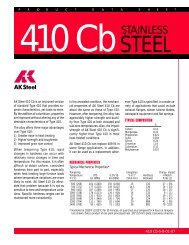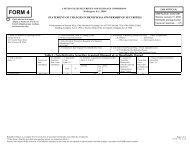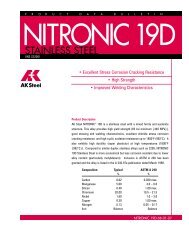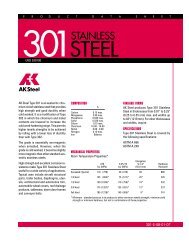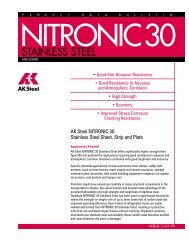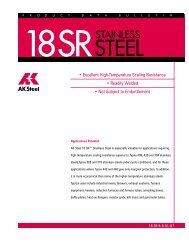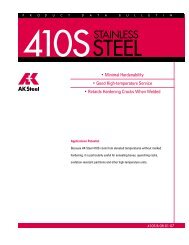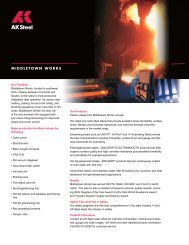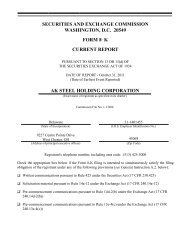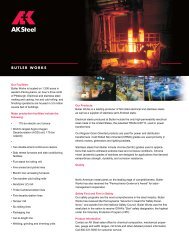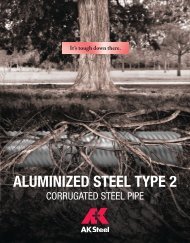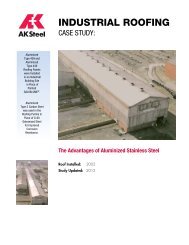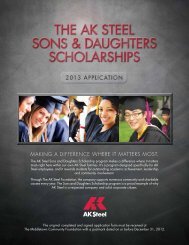Stainless Steel Comparator - AK Steel
Stainless Steel Comparator - AK Steel
Stainless Steel Comparator - AK Steel
You also want an ePaper? Increase the reach of your titles
YUMPU automatically turns print PDFs into web optimized ePapers that Google loves.
<strong>Stainless</strong> <strong>Steel</strong> <strong>Comparator</strong>
Welcome to <strong>AK</strong> <strong>Steel</strong>’s Family<br />
of <strong>Stainless</strong> <strong>Steel</strong>s<br />
This product comparator reviews the fundamentals of stainless<br />
steels. It compares the types, grades, chemistries, finishes and applica-<br />
tions of stainless produced by <strong>AK</strong> <strong>Steel</strong>. The basic product information<br />
contained in the following pages will help you match the application<br />
needs with a specific grade of stainless steel.<br />
What is <strong>Stainless</strong> <strong>Steel</strong>?<br />
In the early nineteen hundreds, metallurgists noticed that chromium<br />
had a greater attraction to oxygen than iron did so they added the<br />
element chromium to steel. Studies prove that when at least 10%<br />
chromium was added, the chrome united with oxygen to form a very<br />
tight transparent layer over the steel surface that prevented rusting by<br />
precluding further oxidation. This transparent layer is self-healing<br />
when damaged by scratches, wear or denting.<br />
<strong>Stainless</strong> steels are materials of enduring beauty. These steels<br />
also withstand the corrosive attack of many acids. They possess<br />
strength and toughness at both extremes of the temperature scale,<br />
yet can be fabricated into intricate shapes for many uses. Because of<br />
this outstanding versatility, stainless deserves careful consideration<br />
for any product where one or more of the following requirements<br />
are involved:<br />
Corrosion Resistance<br />
Strength at Elevated Temperatures<br />
Strength and Ductility at Cryogenic Temperatures<br />
Oxidation Resistance at High Temperatures<br />
Appearance<br />
Abrasion Resistance<br />
Let’s Go to Class<br />
There are more than 250 different stainless steels. These various<br />
grades of stainless are divided into five major families or classes.<br />
The general classes have been developed to consolidate the<br />
chemistries and mechanical properties required to meet specific customer<br />
application needs.<br />
Martensitic <strong>Stainless</strong> <strong>Steel</strong>s<br />
These steels of the 400 series usually contain a minimum of 11.5%<br />
up to 18% chromium and have higher levels of carbon than ferritics.<br />
They are capable of being heat treated to a wide range of useful hardness<br />
and strength levels, and are used extensively in cutlery, sports<br />
knives and multipurpose tools.<br />
Ferritic <strong>Stainless</strong> <strong>Steel</strong>s<br />
This group of steels in the 400 series contains 10.5% to 20% chromium<br />
for corrosion resistance and resistance to scaling at elevated<br />
temperatures. They are nonhardenable by heat treating and are<br />
always magnetic. Ferritic stainless is used in applications where resistance<br />
to corrosion is important, such as automotive emission control<br />
exhaust systems.<br />
Austenitic <strong>Stainless</strong> <strong>Steel</strong>s<br />
Austenitic stainless steels are the most specified grades produced<br />
because of their excellent formability and corrosion resistance.<br />
All 200 and 300 series steels are austenitic and contain<br />
15% to 30% chromium and 2% to 20%<br />
nickel for enhanced surface quality, formability<br />
and increased corrosion and wear<br />
resistance. They are non-magnetic in<br />
the annealed condition and depending<br />
on the composition, primarily<br />
the nickel content, they become<br />
slightly magnetic when cold<br />
worked. These steels are used for<br />
automotive trim, cookware, processing<br />
equipment and a variety<br />
of industrial applications.
Precipitation-Hardening<br />
<strong>Stainless</strong> <strong>Steel</strong>s<br />
There are two general areas of PH grade stainless<br />
steels; martensitic and semi-austenitic. The martensitic<br />
group includes 17-4 PH® and 15-5 PH® chromiumnickel,<br />
with columbium and copper additions. They<br />
develop their high strength and hardness through heat<br />
treatment, which precipitates the copper. The martensitic<br />
PH steels are used in aerospace, chemical and<br />
petrochemical, and food processing applications.<br />
The semi-austenitic grades are 17-7 PH® and<br />
PH 15-7 Mo®. They are austenitic in the annealed<br />
state, but martensitic in the hardened condition.<br />
17-7 PH stainless has excellent high strength and<br />
fatigue properties, and is used in aerospace components.<br />
PH 15-7 Mo stainless is used in applications<br />
requiring high strength and hardness, such as retaining<br />
rings, springs and aircraft bulkheads.<br />
Duplex <strong>Stainless</strong> <strong>Steel</strong>s<br />
These alloys have a mixture of austenite and ferrite<br />
in their structure. They exhibit characteristics of both<br />
phases with higher strength and ductility. Nitrogen is<br />
added to second generation duplex alloys and<br />
provides strength and increased weldability.<br />
<strong>AK</strong> <strong>Steel</strong>’s NITRONIC® 19D has good<br />
cyclic oxidation, high strength<br />
and excellent stress corrosion<br />
resistance, and the<br />
2205 alloy provides<br />
very good pitting<br />
and uniform corrosion<br />
resistance,<br />
high strength and<br />
high resistance to<br />
stress corrosion<br />
cracking.<br />
Alloys Make the Grade<br />
The manufacture of quality stainless steel, from heat to heat and<br />
year to year, demands precise control of raw material ingredients and<br />
melting practices. Exact quantities of presorted scrap and alloying<br />
elements are delivered to the melting furnaces so that the heats or<br />
lots will be within specified composition ranges. Those composition<br />
ranges typically include a group of chemical elements for each grade<br />
of stainless steel.<br />
Alloying Elements<br />
Following is a brief look at the alloying elements found in stainless<br />
steels and their functions.<br />
Chromium forms a<br />
surface film of chromium<br />
oxide to make the stainless<br />
steel corrosion resistant.<br />
It also increases the scaling<br />
resistance at elevated<br />
temperatures.<br />
Nickel stabilizes the<br />
austenitic structure and<br />
increases ductility, making<br />
stainless steel easier to form.<br />
It increases high temperature<br />
strength and corrosion<br />
resistance, particularly in<br />
industrial and marine atmospheres,<br />
chemical, food and<br />
textile processing industries.<br />
Silicon increases scaling<br />
resistance by forming a tight<br />
initial scale, which will<br />
withstand cyclic temperature<br />
changes. It resists carburizing<br />
at high temperatures and<br />
slightly increases tensile<br />
strength and hardness. Small<br />
amounts of silicon are added<br />
to all grades of stainless for<br />
deoxidizing.<br />
Manganese promotes<br />
the stability of austenite,<br />
at or near room temperature<br />
and improves hot working<br />
properties. Addition of up to<br />
2% manganese has no effect<br />
on strength, ductility and<br />
toughness. Manganese is<br />
important as a partial replacement<br />
of nickel in 200 series<br />
stainless grades.<br />
Molybdenum increases<br />
corrosion resistance, strength<br />
at elevated temperatures, and<br />
creep resistance. It expands the<br />
range of passivity and counteracts<br />
tendency to pit especially<br />
in chloride environments.<br />
Aluminum is a very<br />
strong ferrite former and lowers<br />
the hardenability of stainless<br />
steel. It improves scaling<br />
resistance.<br />
Carbon strengthens<br />
stainless steel but promotes<br />
the formation of precipitates<br />
harmful to corrosion resistance.<br />
Columbium combines<br />
with carbon to reduce susceptibility<br />
to intergranular corrosion.<br />
It acts as a grain refiner and<br />
promotes the formation of ferrite.<br />
Copper is added to<br />
stainless steels to increase<br />
their resistance to certain<br />
corrosive environments. It also<br />
decreases susceptibility to<br />
stress corrosion cracking and<br />
provides age-hardening effects.<br />
Titanium combines with<br />
carbon to reduce susceptibility<br />
to intergranular corrosion. It<br />
acts as a grain refiner and promotes<br />
the formation of ferrite.
Typical Chemical Composition %<br />
<strong>Stainless</strong> Types Cr Ni C Other Significant<br />
Elements<br />
Characteristics Typical Applications<br />
Ferritic <strong>Stainless</strong> <strong>Steel</strong>s<br />
409 11 – .01 Ti – .20 Economical corrosion and Heat exchangers, furnace liners,<br />
oxidation resistance automotive exhaust systems<br />
Aluminized 409 11 – .01 Ti – .20 Economical corrosion, oxidation, Heat exchangers, furnace liners,<br />
Aluminum coating salt and cosmetic corrosion resistance automotive exhaust systems<br />
409 Ni 11 0.85 .02 Ti – .20, Mn – .75 Corrosion resistance superior to Coal handling equipment, exhaust<br />
mild and low-carbon steels flanges, transportation equipment<br />
400 12 – .015 Al – .15 Corrosion resistance comparable Applications requiring improved<br />
to 409, better surface finish finish over Type 409, caskets<br />
400 Cb 11.5 – .01 Cb – .15, Al – .15 Corrosion resistance comparable Electrical cabinetry<br />
to 409, better surface finish<br />
410S 12 – .015 Low-cost, general purpose Mild corrosive service<br />
Fractionation towers<br />
11 Cr-Cb 11 – .01 Si – 1.30, Cb – .35 More oxidation and creep resistant High-temperature use, furnaces,<br />
than 409 and 439 auto exhaust components<br />
41003 11 .40 .02 Si – .40, Mn – .80 Excellent weldability, toughness and Tubing for bus frames, hopper cars,<br />
fabricating characteristics chutes, storage tanks and<br />
shipping containers<br />
430 16.5 – .05 General-purpose corrosion Appliance, food equipment, mis-<br />
resistance cellaneous automotive, flue liners<br />
434 16.5 – .065 Mo – 1.0 Improved corrosion resistance Automotive trim<br />
over 430<br />
436 16.8 – .06 Mo – 1.0, Cb – .40 Controlled roping Automotive trim<br />
439 17 – .012 Ti – .30 Wet corrosion and oxidation Heating units, welded tubing and<br />
resistance auto exhaust components<br />
Aluminized 439 17 – .012 Ti – .30 Economical corrosion oxidation, Heating units, welded tubing and<br />
salt and cosmetic corrosion resistance auto exhaust components<br />
435 Mod. 19.5 – .02 Cb – .70, Cu – .50 Improved formability Automotive trim<br />
and weldability<br />
18 SR 17 – .02 Al – 1.70, Ti – .20 High-temperature scaling Industrial ovens, heat<br />
resistance exchangers, furnace liners<br />
18 Cr-Cb 17.5 – .02 Ti – .25, Cb – .55 Oxidation resistant, creep resistant Heat exchangers, furnace com-<br />
ponents, auto exhaust systems<br />
444 17.5 – .015 Ti – .25, Cb – .15 Oxidation, corrosion and stress Water heaters, solar panels,<br />
Mo – 2.0 cracking resistance engine components<br />
Martensitic <strong>Stainless</strong> <strong>Steel</strong>s<br />
410 11.5 – .14 General purpose, hardenable Cutlery, machine parts<br />
410H 11.5 – .18 Increased hardenability Cutlery, rulers<br />
420 12.5 – .38 Increased hardenability Cutlery, multifunctional tools<br />
420 HC 12.5 – .42 Increased hardenability Cutlery, scissors<br />
<strong>AK</strong> <strong>Steel</strong>
Typical Chemical Composition %<br />
<strong>Stainless</strong> <strong>Steel</strong><br />
<strong>Stainless</strong> Types Cr Ni C Other Significant<br />
Elements<br />
Characteristics Typical Applications<br />
Austenitic <strong>Stainless</strong> <strong>Steel</strong>s<br />
201 16 3.5-5.0 .06 Mn – 6-7.5 Low nickel, high work hardening Hose clamps, cookware<br />
NITRONIC® 30 16 2.5 .02 Mn – 8.5, N – .17 High strength, abrasion resistance, Hose clamps, truck and bus<br />
good formability frames, bulk solids handling<br />
equipment, coal buckets and<br />
hopper cars<br />
301 17 7 .10 High strength, high work hardening Wheel covers, springs, hose<br />
clamps, food processing<br />
equipment<br />
304 18 8 .06 Multipurpose Food equipment, tubing,<br />
architectural trim<br />
304L 18 9 .02 Low carbon minimizes carbide Welded parts and other 304<br />
precipitation during welding applications<br />
309S 22 12.5 .05 Oxidation resistant Heating elements, furnace parts<br />
316 16.5 10.5 .05 Mo – 2 Pitting corrosion resistance Heat exchangers, chemical<br />
equipment, marine applications<br />
316L 16.5 10.8 .02 Mo – 2 Low carbon minimizes carbide Welded Type 316 applications<br />
precipitation during welding<br />
321 17 9.5 .02 Ti – 5XC min. Titanium stabilized Heat exchangers to intermediate<br />
temperatures, aircraft<br />
Precipitation-Hardening <strong>Stainless</strong> <strong>Steel</strong>s<br />
17-4 PH® 15.5 4.5 .05 Cu – 3.0, Cb – .25 High strength and hardness Aerospace, chemical and<br />
petrochemical, food processing<br />
15-5 PH® 14.5 4.5 .05 Cu – 3.5, Cb – .25 High strength and hardness, Aerospace, chemical and<br />
ferrite free petrochemical, food processing<br />
17-7 PH® 17 7 .085 Al – 1.0 High strength, excellent fatigue Aerospace components, flat<br />
properties springs<br />
PH 15-7 Mo® 14.5 7.5 .085 Mo – 2.0, Al – 1.0 High strength and hardness Retaining rings, springs, aircraft<br />
bulkheads<br />
Duplex <strong>Stainless</strong> <strong>Steel</strong>s<br />
NITRONIC 19D 21 1.25 .02 Cu – 0.5, Mn – 5.0 Ferrite/austenite matrix, good cyclic Tubing, water heater tanks<br />
oxidation, high strength and good<br />
stress corrosion resistance<br />
2205 22 5.5 .02 Mo – 3.0 High strength, low thermal expansion, Heat exchangers, pipe, pressure<br />
high resistance to stress corrosion vessels, tanks, fans, shafts and<br />
cracking and corrosion fatigue press rolls
Aluminized <strong>Steel</strong> Type 1 <strong>Stainless</strong> <strong>Steel</strong>s<br />
Aluminum coated 409 and 439 stainless steels were developed<br />
to provide the automotive industry with longer life exhaust<br />
system materials. The Type 1 hot-dipped aluminum coating<br />
provides excellent resistance to mu�er condensate corrosion<br />
and pitting from road salt which allows the exhaust system to<br />
remain virtually rust free, thus retaining its good appearance.<br />
Black Coat <strong>Stainless</strong> <strong>Steel</strong>s<br />
<strong>AK</strong> <strong>Steel</strong> Black Coat stainless steels a re available as Type 409,<br />
Aluminized 409, Type 439, and <strong>AK</strong> <strong>Steel</strong> 18 Cr-Cb. The Black<br />
Coat system is a multi-layer surface coating continuously<br />
applied to stainless steel coils. It is especially useful for<br />
applications requiring an attractive cosmetic appearance at<br />
high temperatures. Black Coat stainless steel products provide<br />
enhanced formability compared to bare stainless alloys. These<br />
products are particularly useful in applications involving the<br />
cold end of exhaust systems such as mu�ers and tail pipes.<br />
Color Lock<br />
<strong>AK</strong> <strong>Steel</strong><br />
Reflections on Finish<br />
Coated <strong>Stainless</strong> <strong>Steel</strong>s Surface �nish is an important element in any speci�cation or purchase<br />
order for stainless steel regardless of the intended end use.<br />
<strong>AK</strong> <strong>Steel</strong> Color Lock stainless steel consists of a �uoropolymer<br />
paint system applied to a clean, pretreated and primed stainless<br />
steel coil. The �uoropolymer top coat is a Duranar® highperformance<br />
coating designed for architectural coil coating<br />
applications. The coating features excellent color retention<br />
and chalk, corrosion, chemical and pollution resistance as well<br />
as good �exibility and adhesion. Color Lock is available in a<br />
wide range of colors for use in metal roo�ng, mansard roofs,<br />
fascias, so�ts and specialty accent applications.<br />
Abrasion– resistant <strong>Steel</strong>s — A<br />
family of steel products developed for<br />
those applications involved in sliding and<br />
impact abrasion.<br />
Air Hardening <strong>Steel</strong> — <strong>Steel</strong>s,<br />
such as low chromium and martensitic<br />
stainless steels, that do not require<br />
quenching to produce hardening by the<br />
martensitic reaction.<br />
Alloying — Alloying, in the common<br />
metallurgical sense, refers to the<br />
dissolving of one or more elements in a<br />
metal to produce a metallic mix or alloy.<br />
Balanced Analysis — A term used<br />
to indicate the relative quantities of<br />
alloying elements necessary to produce<br />
the speci�ed properties or metallurgical<br />
structures in a speci�c type of steel.<br />
Bright Annealed — Bright annealing<br />
prevents the formation of undesirable<br />
scale that occurs on the surface of steel<br />
during the annealing process. During typical<br />
annealing, t he heated steel combines<br />
with oxygen in the air to form a layer of<br />
oxide on the steel’s surface. In bright<br />
annealing, the steel is heated in a furnace<br />
�lled with hydrogen or nitrogen gases,<br />
which prevents oxide scale formation.<br />
And, for those applications in which appearance is important, �nish<br />
is a design element and must be speci�ed.<br />
I n architecture or other highly visible applications, the appearance<br />
of stainless steel is a critical design element and speci�cation<br />
of the wrong �nish can alter the desired e�ect. In consumer products,<br />
the gleam of well-polished stainless steel has strong sales<br />
appeal. In institutional kitchen, restaurant, and hospital applications,<br />
properly �nished stainless helps to emphasize the feeling of<br />
cleanliness.<br />
I n addition to visual appeal of polished stainless, there are a<br />
number of functions served by properly prepared stainless surfaces. In<br />
sanitary applications, polished stainless steel not only looks clean,<br />
but also is easy to clean and keep clean.<br />
There are also economic considerations in specifying �nish. For<br />
example, a cold rolled bright annealed �nish might be speci�ed instead<br />
of a more expensive No. 8 polished �nish; or some proprietary rolled<br />
�nishes might serve the same purpose as a No. 4 polished �nish. A<br />
knowledge of �nishes can sometimes result in signi�cant savings.<br />
<strong>Stainless</strong> <strong>Steel</strong> Sheet Finishes<br />
No. 1 — A rough, dull surface<br />
that results from hot<br />
rolling to the speci�ed thickness<br />
followed by annealing and<br />
descaling.<br />
No. 2D — A dull �nish<br />
produced by cold rolling to<br />
gauge, then annealing and pickling<br />
in acid to remove scale and<br />
oxide from an open air anneal.<br />
No. 2B — A re�ective coldrolled<br />
�nish produced<br />
in the same manner as a 2D<br />
Sheet Finish, except that a light<br />
temper pass on polished rolls<br />
is performed on the annealed<br />
and pickled product. This is<br />
the general-purpose cold-rolled<br />
�nish that can be used as is,<br />
or as a preliminary step to<br />
polishing.<br />
Glossary of <strong>Stainless</strong> Sheet and Strip Terms<br />
Bu�ng — A polishing operation<br />
utilizing a very �ne abrasive compound<br />
on a prepared rotating wheel, which contacts<br />
the work surface.<br />
Duplex — <strong>Steel</strong>s exhibiting both<br />
austenitic and ferritic structures.<br />
Intergranular Corrosion — Corrosion<br />
that occurs at the grain boundaries<br />
in austenitic stainless steels that have<br />
been heat treated between 850˚ and<br />
1450˚F. Usually caused by precipitation of<br />
the chrome carbides.<br />
Orange Peel — Roughening of the<br />
surface sometimes encountered in forming<br />
or drawing stainless steels that have<br />
a coarse grain structure.<br />
Oxide Film Theory — An explanation<br />
of passivity based upon the supposition<br />
that a relatively impermeable layer of<br />
oxide forms on the surface of stainless steel<br />
that retards attack by corrosives.<br />
Passivity — The ability of certain<br />
metals and alloys, especially the stainless<br />
steels, to resist normal corrosion to the<br />
point where the metal remains unattacked.<br />
©2007 <strong>AK</strong> <strong>Steel</strong> Corporation<br />
<strong>AK</strong> <strong>Steel</strong>, the <strong>AK</strong> <strong>Steel</strong> logo, 17-4 PH, 15-5 PH, 17-7 PH, PH 15-7 Mo, NITRONIC and Unibrite<br />
are registered trademarks of <strong>AK</strong> <strong>Steel</strong> Corporation. G reystone, Black Coat and Color Lock a re<br />
trademarks of <strong>AK</strong> <strong>Steel</strong> Corporation. Duranar is a registered trademark of PPG Industries.
Bright Annealed — A highly<br />
reflective cold-rolled finish<br />
produced by cold rolling to<br />
gauge, then bright annealing<br />
in a protective inert atmosphere.<br />
This process results in no<br />
scaling of the product, leaving<br />
a bright reflective finish. A<br />
light temper pass on polished<br />
rolls is performed on the brightannealed<br />
product. This finish is<br />
also available without the final<br />
temper pass, in which case the<br />
finish is not quite as bright.<br />
Unibrite® — <strong>AK</strong> <strong>Steel</strong>’s high<br />
luster finish, produced in<br />
the same manner as a Bright<br />
Annealed Finish, except that<br />
the product is conditioned on<br />
a mill buffing unit. This process<br />
results in a finish with uniform<br />
color and reflectivity. It is<br />
comparable to a No. 7 Sheet<br />
Finish, per ASTM A 480.<br />
No. 3 — A polished finish<br />
produced in the same<br />
manner as a 2B Sheet Finish,<br />
except that the product is belt<br />
polished using 120 grit emery<br />
cloth belts.<br />
No. 4 — A polished finish<br />
similar to No. 3 Polish,<br />
except that the product is belt<br />
polished using 150 grit emery<br />
cloth belts, giving it a somewhat<br />
smoother appearance than No. 3.<br />
Precipitation Hardening — Hardening<br />
that is caused by the precipitation<br />
of a metallic compound from a supersaturated<br />
solid solution.<br />
Retained Austenite — A tendency<br />
in martensitic alloys that increases with<br />
the alloy and carbon content and with<br />
rate of cooling, to retain at room temperature<br />
a fraction of the austenite phase<br />
that is stable at the high temperature and<br />
which fails to transform to martensite on<br />
cooling.<br />
Unigrain — A rolled-on grit<br />
finish produced in the same<br />
manner as a 2B Sheet Finish,<br />
except that grit rolls are substituted<br />
for polished rolls on the<br />
light temper pass. This product<br />
results in a uniform finish that<br />
can be substituted for polish<br />
finish in many applications.<br />
TM — A rolled-on dull finish<br />
produced in the same manner<br />
as a 2B Sheet Finish, except<br />
that shot-blasted rolls are substituted<br />
for polished rolls on the<br />
light temper pass. This product<br />
results in a dull, nondirectional<br />
finish that is suitable for many<br />
painting and coating applications.<br />
<strong>Stainless</strong> <strong>Steel</strong> Strip Finishes<br />
No. 1 — A dull gray matte to<br />
a fairly reflective finish,<br />
depending on the stainless steel<br />
grade, produced by cold rolling,<br />
annealing and pickling. This<br />
finish is used for severely drawn<br />
or formed parts, as well as<br />
applications where the brighter<br />
No. 2D finish is not required.<br />
No. 1 finish for strip approximates<br />
No. 2D finish for sheet.<br />
No. 2 — A smooth reflective<br />
surface produced by the<br />
same processing used for No. 1<br />
finish followed by a final light cold<br />
rolling pass, which is generally<br />
Roping — A fibrous surface pattern<br />
that can occur in 400 series sheet<br />
and strip when stretched or drawn. This<br />
pattern is always in the rolling direction<br />
and may require metal removal by polishing<br />
if a smooth surface is desired.<br />
Semi-hardening — A hardening<br />
treatment for martensitic steels in which<br />
the metal is quenched from such a low<br />
austenitizing temperature that only a<br />
portion of the metal transforms, yielding<br />
a semimartensitic alloy particularly<br />
adaptable to machining operations.<br />
done using highly polished rolls.<br />
No. 2 for strip is a general-purpose<br />
finish widely used for<br />
household appliances, automotive<br />
trim, tableware and utensils.<br />
No. 2 finish for strip approximates<br />
No. 2D finish for sheet.<br />
Bright Annealed — A bright,<br />
cold rolled, highly<br />
reflective finish retained by<br />
final annealing in a controlledatmosphere<br />
furnace. The<br />
purpose of atmosphere<br />
control is to prevent scaling<br />
or oxidation during annealing.<br />
The atmosphere usually consists<br />
of dry hydrogen.<br />
Mill-Buffed — Is a highly<br />
reflective finish obtained<br />
by sending either No. 2 or<br />
bright annealed strip through<br />
a continuous buffing pass.<br />
The buffing provides a finish<br />
that is uniform in color and<br />
reflectivity. This finish is used<br />
for automotive trim, household<br />
trim, tableware, utensils and<br />
plumbing fixtures.<br />
<strong>AK</strong> <strong>Steel</strong> Custom Finishes<br />
Embossed — An imprinted<br />
overall design on the surface<br />
of cold rolled stainless steel<br />
produced by passing the steel<br />
between rolls etched with the<br />
design pattern. <strong>AK</strong> <strong>Steel</strong>’s<br />
Sensitization — A term used to<br />
describe the condition of the austenitic<br />
stainless steels resulting from heating<br />
them in the temperature range of approximately<br />
800˚ to 1500˚F and cooling to<br />
room temperature. When the metal is held<br />
in the sensitization range, the carbon in<br />
the steel combines with some of the<br />
chromium and precipitates as chromium<br />
carbide at the grain boundaries. This<br />
depletes chromium in the area of the<br />
grain boundaries and makes the metal<br />
susceptible in those areas to attack in<br />
some corrosive media.<br />
embossed stainless steel is<br />
suitable for a wide variety of<br />
decorative applications.<br />
Leinen — A rolled-on,<br />
reflective, linen-like finish<br />
produced in the manner similar<br />
to a bright annealed and temper<br />
rolled product. The<br />
non-directional glossy gray<br />
surface finish is an embossed<br />
pattern applied in the temper<br />
rolling operation, and either<br />
annealed or bright annealed.<br />
<strong>Steel</strong>’s Leinen Finish is suitable<br />
for elevator doors, trim, ceiling<br />
panels and column covers.<br />
Greystone Bright — A rolledon,<br />
reflective, pebble-like<br />
finish produced in a manner<br />
similar to a bright annealed<br />
and temper rolled product.<br />
With its random pattern, which<br />
allows for seamless connection<br />
of pieces, Greystone Bright<br />
is ideal for moldings and trim,<br />
elevator door panels, and<br />
exterior building panels.<br />
Greystone Dull — A rolled-on,<br />
dull, pebble-like finish<br />
produced on an annealed<br />
and pickled substrate in a<br />
manner similar to a 2B Sheet<br />
Finish. Initially designed for<br />
roofing applications to minimize<br />
the glare of sunlight, Greystone<br />
Dull Finish is ideal for a variety<br />
of architectural applications.<br />
Sigma Phase — A brittle and hard<br />
intermetallic compound of the general<br />
formula FeCr, but having a composition<br />
range of broad extension, tending to form<br />
particularly in the ferrite of high chromium<br />
stainless steels when heated for a<br />
period of time in the general range of<br />
925˚ to 1750˚F.<br />
Subzero Treatment — Part of a<br />
hardening treatment in which the martensitic<br />
steel is quenched from the austenizing<br />
temperature and brought immediately<br />
to a very low temperature to promote the<br />
development of martensite — particularly<br />
useful for steels tending to have<br />
“retained austenite”.
<strong>AK</strong> <strong>Steel</strong> Corporation<br />
9227 Centre Pointe Drive<br />
West Chester, OH 45069<br />
www.aksteel.com<br />
Customer Service<br />
800-331-5050



